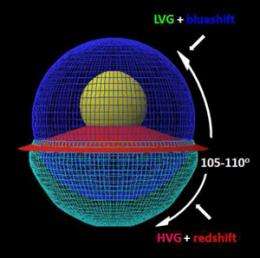A schematic picture of the structure of a supernova Ia. The ashes of the first phases of the explosion, right after ignition (yellow), are offset with respect to the centre of the ejected material. Depending on where we view the supernova from, it will demonstrate different spectral properties.
(PhysOrg.com) -- Supernovae are gigantic stellar explosions that can be seen across the entire universe. Type Ia supernovae are a relatively homogeneous class of stellar explosions, which researchers use as 'standard candles' to observe the acceleration of the universe. It has long been known, however, that they exhibit considerable variation in their spectra and the origin of the differences has been unknown.
Now researchers, including scientists from the Niels Bohr Institute, have solved the mystery. They have shown that the supernovae are exploding asymmetrically and the difference in their appearance is simply due to the directions from which the supernovae are being observed. The results have just been published in the scientific journal, Nature.
Type Ia supernovae have played a crucial role in cosmology because they can be used to measure the distances across the universe. Even though they are not perfect ‘standard candles' (their luminosity can vary by up to 50 %), they can still be standardized based on the knowledge that the brightest supernovae fade more slowly, while the weaker fade more quickly.
There is now broad consensus that the relative homogeneity of type Ia supernovae is due to their having the same origin, namely a white dwarf in a binary system, where the two stars circle each other. A white dwarf is the type of star that our sun will become in the end of its life when it has run out of hydrogen. The white dwarf absorbs material thrown out from its companion star and when it reaches 1.4 solar masses it explodes as a supernova.
The true story, however, is more complicated. Supernovae that fade in the same way may exhibit quite different behaviour in how fast their expanding material slows down (the so-called velocity gradient). This fact has raised doubts about whether type Ia supernovae could be used as cosmological standard candles.
"With new detailed studies we have now shown that the velocity gradient is closely associated with these supernovae exploding asymmetrically", explains astrophysicist Jesper Sollerman, Dark Cosmology Centre at the Niels Bohr Institute at the University of Copenhagen.
New detailed studies by an international team including Keiichi Maeda, University of Tokyo and Giorgos Leloudas, Jesper Sollerman and Max Stritzinger from the Dark Cosmology Centre have shown that the velocity gradient is closely associated with an asymmetrical character of the explosions of these supernovae.
"What we could see was that the varying natures of the supernovae could be explained by an asymmetric explosion, where the ignition takes place away from the centre. So the different appearances of the supernovae simply depend on the point of view they are observed from", explains Giorgos Leloudas from the Dark Cosmology research group.
While there had already been indications from previous observations of type Ia supernovae that they might explode asymmetrically, this is the first time that it has been convincingly shown by observational studies probing the supernova central regions. The researchers observed the supernovae in the late stages where it is possible to see deep into their interior and like this confirm that they really explode asymmetrically.
"Besides giving us new insight into how these stars explode and solving the problem with their different appearances, the results are also good news for the use of supernovae as standard candles. If we just observe enough supernovae, the differences from the angles will even out", point out the three researchers from the Niels Bohr Institute, Giorgos Leloudas, Jesper Sollerman and Max Stritzinger.
Provided by Niels Bohr Institute























